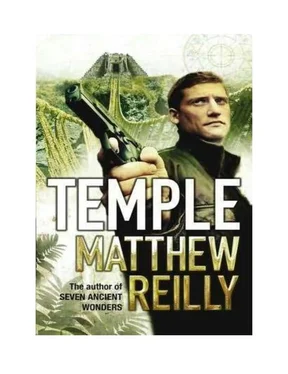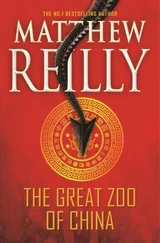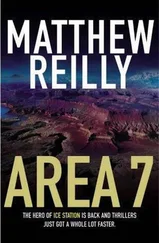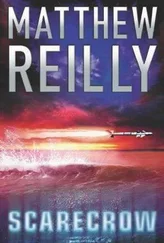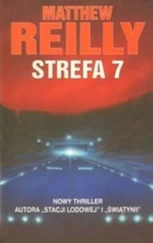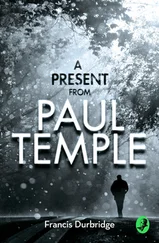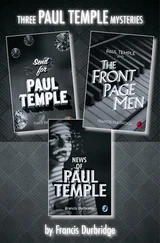A collection of coloured wires snaked out from the titanium chamber in the centre of the device, most of them disappearing into a laptop computer keyboard that was crudely attached to its front section.
For the moment, the small titanium chamber was empty.
For the moment.
The thieves didn’t waste any time. They removed the entire device from its power generator and quickly placed it on a custom-made sling.
Then they were moving again. Out the door. Up the corridor. Left then right. Left then right. Through the brightly lit government maze, stepping over the bodies they had killed on their way in. In the space of ninety seconds, they arrived back at the underground garage, where they all piled back into the van, together with their prize. No sooner was the last man’s feet inside than the van’s wheels skidded against the concrete and the big vehicle peeled away from the loading dock and sped out into the night.
The team’s leader looked at his watch..5:59 am.
The entire operation had taken nine minutes.
Nothing more. Nothing less.
FIRST MACHINATION
Monday, January 4, 0910 hours
William Race was late for work. Again.
He’d overslept and then the subway had been delayed and now it was ten after nine and he was late for his morning lecture. Race’s office was on the third floor of the old Delaware Building at New York University. The building had an ancient wrought-iron elevator that travelled at a snail’s pace. It was quicker to take the stairs.
At thirty-one, Race was one of the youngest members of staff in the Ancient Languages Department at NYU. He was of average height—about five-foot-nine and handsome in a very unassuming kind of way.
He had sandy-brown hair and a lean physique. A pair of wire-rimmed glasses framed his blue eyes and an unusual facial mark—a triangular brown birthmark situated directly below his left eye.
Race hurried up the stairs, a thousand thoughts running through his mind—his morning lecture on the works of the Roman historian Livy, the parking fine from last month that he still had to pay, and the article that he’d read in the New York Times that morning saying that because 85 per cent of people based their ATM numbers on important dates like birthdays and the like, thieves who stole their wallets—thus obtaining not only ATM cards, but also driver’s licences containing the owners’ dates of birth—were finding it easier to break into their bank accounts. Damn it, Race thought, he was going to have to change his PIN number.
He came to the top of the stairwell and hurried out into the corridor.
And then he stopped.
Two men stood in the hallway in front of him.
Soldiers.
They were decked out in full battle dress, too-helmets, body armour, M-16s, the lot. One stood halfway down the corridor, nearer to Race.
The other was stationed further down the hall. He stood rigidly to attention outside the door to Race’s office. They couldn’t have looked more out of place—soldiers in a university.
Both men snapped around immediately when they saw him burst out from the stairwell. For some reason, in their presence, Race suddenly felt inferior somehow unworthy, undisciplined. He felt stupid in his Macy’s sports coat, jeans and tie, carrying his clothes for a lunchtime baseball game in a battered old Nike sports bag.
As he approached the first soldier, Race looked him up and down—saw the black assault rifle in his hands, saw the velveteen green beret slouched on his head, saw the crescent-shaped patch on his shoulder that read: SPECIAL FORCES.
‘Uh, hi. I’m William Race. Ira’
‘Its okay, Professor Race. Please go in. They’re expecting you.’
Race continued down the corridor, came to the second soldier. He was taller than the first one, bigger. In fact, he was huge, a mountain of a man—at least six-feet-four—with a soft handsome face, dark hair and narrow brown eyes that didn’t miss a trick. The name patch on his breast pocket read: VAN LEWEN. The three stripes on his shoulder indicated that he was a sergeant.
Race’s eyes drifted to the man’s M-16. It had a state-of-the-art PAC-4C laser sighting device mounted on its barrel and an M-203 grenade launcher attached to its underside.
Serious stuff.
The soldier stepped aside promptly, allowed Race to enter his own office.
Dr John Bernstein was sitting in the high-backed leather chair behind Race’s desk, looking very uncomfortable.
Bernstein was a white-haired man of fifty-nine and the head of the Ancient Languages Department at NYU.
There were three other men in the room. Two soldiers, one civilian. The two soldiers were dressed and armed in much the as the guards outside fatigues, helmets, M-16s—and they both looked extremely fit. One to be a little older than the other. He held his formally, wedged firmly between his elbow and ribs, and he had close-cropped black hair that barely his forehead. Race’s sandy-brown hair fell down into his eyes.
The third stranger in the room, the civilian, was seated in the guest’s chair in front of Bernstein. He was a big man, and dressed in shirtsleeves and trousers. He had a pug nose and dark heavy-set features that were a sign of age and responsibility. And he sat in his chair with the calm assurance of someone who was used to being obeyed.
Race got the distinct impression that everyone had been waiting in his office for some time.
Waiting for him.
‘Will,’ John Bernstein said, coming around the desk and shaking his hand. “Good morning. Come on in. I’d like you to meet someone. Professor William Race, Colonel Frank Nash.’
The barrel-chested civilian extended his hand. Strong grip.
‘Retired. Good to meet you,’ he said, looking Race over.
He then indicated the two soldiers. ‘This is Captain Scott and Corporal Cochrane of the U.S. Army Special Forces Group.’
‘Green Berets,” Bernstein whispered respectfully in Race’s ear.
Then Bernstein cleared his throat. ‘Colonel er, I mean, Doctor—Nash is from the Tactical Technology Office at the Defense Advanced Research Projects Agency. He’s come here seeking our help.’
Frank Nash handed Race his photo-ID card. Race saw a mug shot of Nash with the red DARPA logo on top of it and a whole lot of numbers and codes beneath it. A magnetic strip ran down one side of the card.
Beneath the photo were the words: FRANCIS K. NASH, U.S. ARMY, COL. (RET.). It was a pretty impressive card. It screamed: important person.
Uh-huh, Race thought.
He had heard of DARPA before. It was the primary research and development arm of the Department of Defense, the agency that had invented the Arpanet, the military-only precursor to the Internet.
DARPA was also famous for its participation in the Have Blue project in the 1970s, the top-secret Air Force project that had resulted in the construction of the F-117 stealth fighters.
In fact, truth be told, Race knew a little more about DARPA than most, for the simple reason that his brother, Martin, worked there as a design engineer.
Basically DARPA worked in partnership with each of the three branches of the U.S. armed forces—the Army, the Navy and the Air Force-developing high-technology military applications appropriate to the needs of each force: stealth technology for the Air Force, ultra-high-tensile body armour for the Army. Such was DARPA’s status, however, that its accomplishments often became the stuff of urban legend. It was said, for example, that DARPA had recently perfected the J-7—the mythical A-frame rocket pack that would ultimately replace the parachute but this had never been proved.
The Tactical Technology Office, however, was the spearhead of DARPA’s arsenal, the jewel in its crown. It was the division in charge of developing the big stuff — high-risk/high-return strategic weaponry.
Читать дальше
